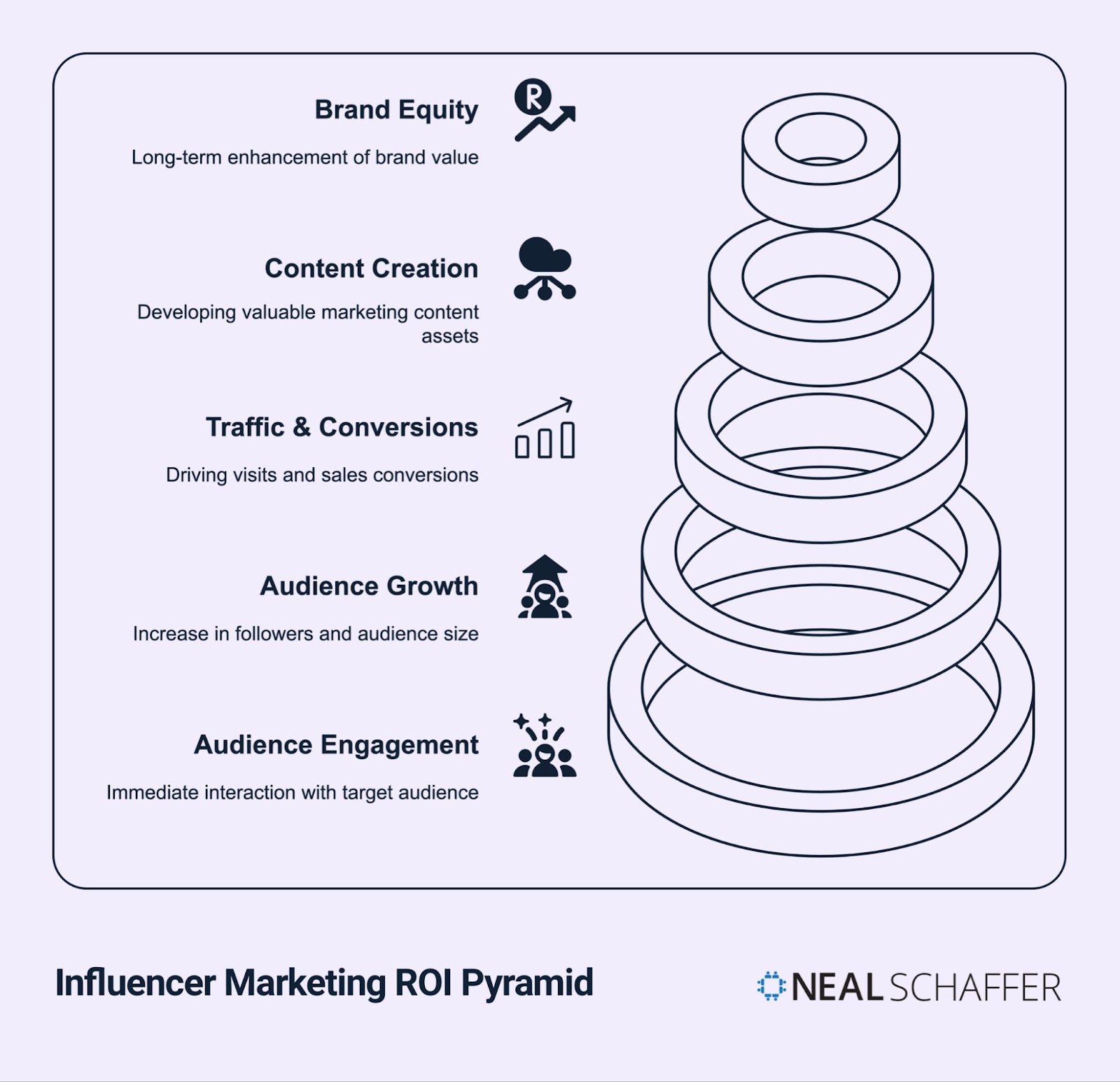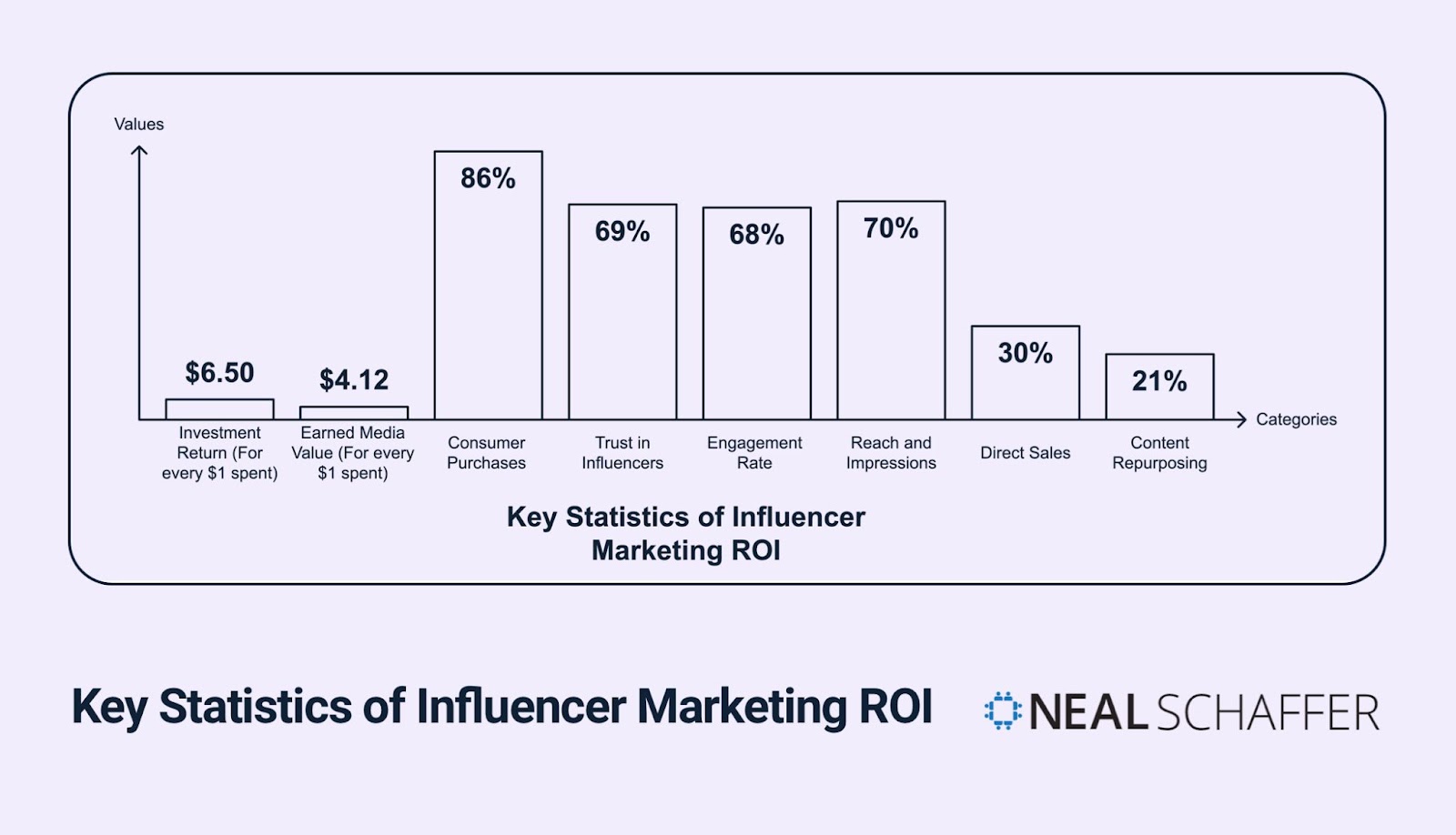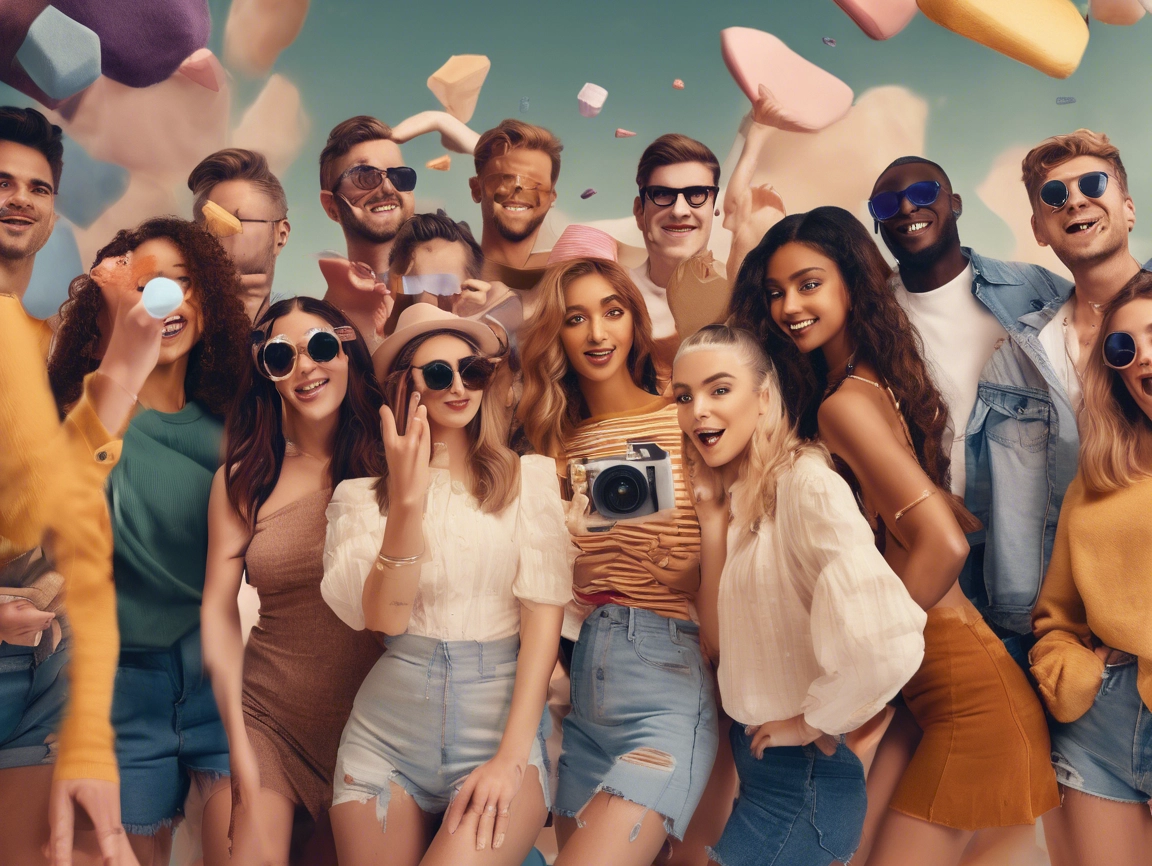I always say that influencer marketing is the least understood yet most powerful type of marketing. I think that one of the reasons why this is the case is because business leaders and marketing executives fail to see the ROI of influencer marketing. I want to change that with this blog post.
As influencer marketing continues to grow as a critical component of modern marketing strategies, this question still remains at the forefront for marketers: “How do we measure its impact?” The ability to calculate and demonstrate return on investment (ROI) has become essential for both justifying increasing influencer marketing budgets and optimizing campaign performance.
Many marketing leaders struggle to quantify influencer marketing’s effectiveness. They face challenges with attribution, measurement consistency, and selecting the right metrics. This complexity often leads to undervalued campaigns and missed opportunities.
In this comprehensive guide, which goes beyond what I wrote in my dedicated chapter on influencer marketing in The Age of Influence, I’ll break down the essential metrics that truly matter for measuring influencer marketing ROI. We’ll explore practical approaches to calculation, address common challenges, and provide a strategic framework for maximizing your returns. Having taught digital marketing at several universities and advised Fractional CMO clients on influencer marketing campaigns, I’ve seen firsthand how proper measurement transforms good campaigns into great ones.
Understanding Influencer Marketing ROI
Influencer marketing ROI represents the measurable return your business receives from its influencer program investments. This return can manifest in multiple forms, from direct sales to brand awareness growth. Calculating it accurately requires both art and science.
The business case for influencer marketing has never been stronger. Businesses are generating $6.50 for every $1 spent on influencer marketing on average. This impressive return outperforms many traditional marketing channels and explains why budgets continue to shift toward influencer strategies.
ROI analysis for influencer marketing differs from traditional advertising in several important ways. Whereas conventional advertising often focuses on immediate conversions, influencer marketing creates value across multiple dimensions and timeframes. Let’s explore the different layers of value creation:
| Value Dimension | Timeframe | Measurement Approach | Business Impact |
|---|---|---|---|
| Audience Engagement | Immediate | Engagement metrics, sentiment analysis | Brand affinity, content validation |
| Audience Growth | Short-term | Follower growth, reach expansion | Larger marketing audience, brand awareness |
| Traffic & Conversions | Short to medium-term | Click tracking, conversion attribution | Direct revenue, lead generation |
| Content Asset Creation | Medium to long-term | Content reuse metrics, engagement over time | Marketing asset development, cost efficiencies |
| Brand Equity Growth | Long-term | Sentiment tracking, brand lift studies | Premium positioning, customer loyalty |
This multi-dimensional view helps marketers understand the full value spectrum of influencer marketing beyond immediate sales. By adopting this comprehensive perspective, you can avoid undervaluing influencer marketing’s contributions to your overall marketing ecosystem.

Common Misconceptions About Measuring ROI
Several misconceptions lead marketers astray when evaluating influencer marketing effectiveness. The first is focusing exclusively on immediate sales. While important, this narrow view misses significant value from brand building, content creation, and audience development.
Another common mistake is applying identical metrics across all campaigns regardless of objectives. Each campaign has unique goals requiring tailored measurement approaches. An awareness campaign demands different metrics than a direct response effort.
Finally, many marketers overlook the long-term value of influencer-generated content. When properly leveraged, this content becomes a valuable marketing asset extending far beyond the initial campaign period. Including this extended value in ROI calculations provides a more accurate assessment.
Key Metrics for Measuring Influencer Marketing ROI
Successful measurement begins with selecting the right metrics aligned with your specific goals. These metrics typically fall into four main categories: engagement, reach and awareness, conversion and sales, and content value. Let’s examine each category in detail.

Engagement Metrics
Engagement metrics measure audience interaction with influencer content. These interactions indicate content resonance and audience interest. Engagement rate remains the most popular success metric, with 68% of marketers prioritizing it for campaign evaluation.
Engagement represents a critical first step in the conversion funnel. Strong engagement signals relevant content that captures audience attention – essential for any subsequent action. Particularly on platforms like TikTok, engagement drives algorithmic distribution, extending organic reach.
When analyzing engagement, look beyond raw numbers to engagement quality. Comments that ask questions or show purchase intent carry more value than simple emoji reactions. This qualitative analysis helps assess true audience interest and potential conversion likelihood.
Audience Reach & Brand Awareness
Reach and awareness metrics help quantify your message’s distribution and subsequent brand recognition. According to marketing professionals, 70% measure ROI through reach and impression metrics, making these crucial benchmarks.
Modern reach metrics go beyond simple impressions to include factors like:
- Unique reach – The number of individual users exposed to content
- Audience growth – New followers gained during campaigns
- Share of voice – Brand mention volume compared to competitors
- Brand sentiment – Emotional response tracking in comments and shares
- Hashtag performance – Spread and adoption of campaign hashtags
These metrics help quantify awareness building, particularly important for brands entering new markets or launching new products. They form the foundation for future conversion opportunities and build long-term brand equity.
Conversion & Sales Metrics
Conversion metrics directly connect influencer activities to business results, making them critical for ROI calculation. These often serve as the most compelling proof points for executive stakeholders focused on bottom-line impact.
The power of influencer marketing to drive purchase decisions is substantial, with 86% of consumers making at least one purchase annually based on influencer recommendations. This statistic underscores the channel’s effectiveness in driving consumer action.
Is Your LinkedIn Not Delivering Results?
Just released: my new book to help professionals, entrepreneurs, and business owners maximize LinkedIn for real growth.
With years of LinkedIn expertise, Maximizing LinkedIn for Business Growth offers actionable steps to build your brand, expand your network, and drive results.
Start leveraging LinkedIn like never before—grab your copy now! Click the cover or button below to buy on Amazon.
Key conversion metrics to track include:
| Metric | Description | Tracking Method | ROI Relevance |
|---|---|---|---|
| Conversion Rate | Percentage of audience taking desired action | Custom URLs, promo codes, pixel tracking | Indicates content effectiveness at driving action |
| Cost Per Acquisition | Cost to acquire each customer or lead | Total campaign cost ÷ Number of acquisitions | Provides efficiency benchmark against other channels |
| Average Order Value | Average purchase amount from influencer traffic | E-commerce platform analytics | Shows quality of traffic and purchase intent |
| Email Sign-ups | New subscribers gained from campaign | Landing page tracking, form analytics | Builds owned audience for future marketing |
| Lead Quality | Conversion rate of influencer-generated leads | CRM tracking, lead scoring | Measures true business value beyond quantity |
These conversion metrics provide the most direct correlation to financial return, making them essential components of any comprehensive ROI analysis. They connect marketing activities directly to revenue generation and business growth.
Content Value & Partnership Metrics
A frequently overlooked dimension of influencer marketing ROI is the value of content assets created. These assets extend campaign value well beyond the initial promotion period. Currently, only 21% of marketers repurpose influencer content on their websites, representing a significant missed opportunity.
When calculating ROI, consider the cost savings from influencer-generated content versus traditional production methods. High-quality influencer content often costs a fraction of professional production while delivering comparable or superior results.
Partnership quality also impacts long-term ROI. Influencers who deeply understand your brand deliver more authentic content and typically generate better results. The 71% of influencers who offer discounted rates for ongoing partnerships create additional value through relationship continuity and deeper brand understanding.
Platform-Specific ROI Considerations
ROI varies significantly across platforms due to different audience behaviors, engagement patterns, and conversion mechanisms. Understanding these differences helps optimize your platform selection and measurement approach.
Instagram ROI Dynamics
Instagram has historically dominated influencer marketing, though recent data shows its usage has declined from 76% to 47% year-over-year among marketers. Despite this shift, it remains a powerful ROI driver for many brands.
Instagram delivers particularly strong results for visual products in fashion, beauty, lifestyle, and travel categories. Its shopping features create direct conversion paths that simplify attribution and ROI measurement. The platform’s format variety (feed posts, Stories, Reels, Lives) allows for multi-touchpoint campaigns that address different funnel stages.
For optimal Instagram ROI, align content formats with specific objectives:
| Instagram Format | Best For | Typical Engagement | Measurement Focus |
|---|---|---|---|
| Feed Posts | Product showcases, announcements | 2-3% engagement rate | Likes, comments, saved posts |
| Stories | Time-sensitive offers, behind-the-scenes | 5-10% tap-through rate | Views, replies, sticker interactions |
| Reels | Awareness, product demonstrations | 20-30% view completion | Plays, shares, comments |
| Lives | Product launches, Q&As | 15-25 minute average view time | Peak concurrent viewers, comments |
Instagram offers strong ROI potential when properly aligned with business objectives and measured with appropriate metrics. For many brands, Instagram delivers approximately $4.12 in earned media value for every $1 spent on influencer marketing, though this varies significantly by industry and campaign type.
TikTok’s Rising ROI Potential
TikTok has rapidly become a priority platform for influencer marketing, with 46.7% of marketers now focusing their efforts there. This shift reflects TikTok’s explosive user growth and exceptional engagement metrics.
The platform offers unique ROI advantages through its algorithm-driven distribution, which can propel content to massive organic reach regardless of creator follower count. This democratized visibility creates opportunities for higher ROI with smaller investments. TikTok nano-influencers (those with 1K-10K followers) achieve an impressive 18% average engagement rate, far exceeding rates on other platforms.
When measuring TikTok ROI, consider:
- Viral potential – Value of unexpected reach beyond target audience
- Trend creation – Impact of starting platform-wide behaviors
- Cross-platform sharing – Content distribution to other networks
- Hashtag performance – Visibility within discovery mechanisms
- Sound adoption – Usage of branded sounds across creators
TikTok’s commerce features continue to evolve, creating increasingly direct paths to purchase that will further enhance attribution capabilities and ROI measurement precision in the near future.
Platform Selection Strategy for Optimal ROI
Maximizing ROI begins with selecting the right platforms for your specific business objectives and audience. Rather than spreading budgets across all platforms, strategic concentration often yields superior returns.
Consider these factors when prioritizing platforms:
- Audience-platform alignment – Where your target demographic is most active
- Content-product fit – Which formats best showcase your offerings
- Conversion mechanism maturity – Platforms with strongest paths to purchase
- Measurement capabilities – Available analytics and attribution tools
- Competitive whitespace – Underutilized platforms in your category
Each platform offers distinct ROI advantages for different objectives. LinkedIn typically delivers stronger results for B2B services, while visual platforms like Instagram excel for consumer products. Match your platform strategy to your specific business goals and audience behavior for optimal returns.
Challenges in Attribution and Measurement
Despite its effectiveness, measuring influencer marketing ROI presents several challenges that complicate attribution and assessment. Understanding these challenges is the first step toward developing more accurate measurement frameworks.
Direct Sales Tracking Limitations
Many marketers struggle with direct attribution of sales to influencer activities. Currently, only 30% of marketers track direct sales as a primary measurement metric, highlighting this challenge.
Several factors contribute to this tracking difficulty:
| Attribution Challenge | Description | Potential Solution |
|---|---|---|
| Multi-touchpoint Journeys | Customers interact with multiple content pieces before purchase | Multi-touch attribution models |
| Cross-device Tracking | Users view content on one device, purchase on another | Unified customer ID systems |
| Offline Conversions | Influence leads to in-store purchases | QR codes, unique offer codes |
| Delayed Conversions | Purchase occurs weeks after initial exposure | Extended attribution windows |
| Platform Limitations | Restricted tracking capabilities on some platforms | Custom URLs, dedicated landing pages |
These challenges necessitate a more sophisticated approach to attribution that accounts for influencer marketing’s role throughout the customer journey rather than just the final conversion point.
Multiple Touchpoint Attribution
Modern customer journeys rarely follow linear paths. Consumers typically interact with brands through numerous channels before making purchase decisions. This complexity requires more nuanced attribution models that account for influencer marketing’s role within the broader marketing ecosystem.
Various attribution approaches offer different perspectives on influencer marketing’s contribution:
- First-touch attribution – Credits the channel that first introduced the customer
- Last-touch attribution – Credits the final touchpoint before conversion
- Linear attribution – Distributes credit equally across all touchpoints
- Time-decay attribution – Gives more credit to touchpoints closer to conversion
- U-shaped attribution – Emphasizes both introduction and conversion points
Most marketers find that a multi-touch attribution model provides the most accurate assessment of influencer marketing’s contribution. This approach acknowledges influencer content’s role in both introducing new prospects and nurturing them toward conversion.
Long-term Value Assessment
Perhaps the most significant measurement challenge involves quantifying influencer marketing’s long-term impact on brand equity, customer lifetime value, and market positioning. These effects extend far beyond immediate campaign periods but contribute substantially to overall ROI.
Advanced measurement approaches incorporate:
- Brand lift studies – Measuring awareness and perception changes
- Customer cohort analysis – Tracking long-term value of influencer-acquired customers
- Sentiment tracking – Monitoring brand perception over time
- Content lifespan analysis – Measuring ongoing performance of evergreen content
- SEO impact assessment – Evaluating search ranking improvements from content
These methodologies provide a more comprehensive ROI picture by capturing value that conventional last-click attribution models miss. They reflect influencer marketing’s true business impact beyond immediate conversions.
Calculating Influencer Marketing ROI: A Step-by-Step Approach
Developing a structured calculation approach helps standardize ROI assessment and creates consistency across campaigns. This methodical process ensures you capture the full spectrum of value generated by your influencer initiatives.
Setting Clear Campaign Objectives
Effective ROI measurement begins with well-defined campaign objectives. These objectives determine which metrics matter most for your specific initiatives. Clear goals also establish benchmarks against which performance can be measured.
Typical campaign objectives include:
| Campaign Objective | Primary Metrics | Secondary Metrics | ROI Calculation Focus |
|---|---|---|---|
| Brand Awareness | Reach, impressions, views | Engagement rate, follower growth | Cost per thousand impressions (CPM) |
| Engagement Building | Likes, comments, shares, saves | Click-through rate, time spent | Cost per engagement (CPE) |
| Traffic Generation | Clicks, website visits, page views | Bounce rate, time on site | Cost per click (CPC) |
| Lead Generation | Form completions, email sign-ups | Lead quality score, conversion rate | Cost per lead (CPL) |
| Sales Conversion | Purchases, revenue generated | Average order value, repeat purchases | Return on ad spend (ROAS) |
By aligning your measurement approach with specific objectives, you create more meaningful ROI assessments that accurately reflect campaign success according to your unique business goals.
Calculating Basic ROI Formula
The fundamental ROI formula provides a starting point for measurement:
ROI = (Value Generated – Campaign Cost) ÷ Campaign Cost × 100%
This formula yields a percentage that indicates return relative to investment. While straightforward, the challenge lies in accurately determining the “Value Generated” component, especially for campaigns focused on non-conversion objectives.
For sales-focused campaigns, value calculation is relatively direct:
Value Generated = Revenue Attributed to Campaign
For non-conversion campaigns, value estimation requires alternative approaches:
- Equivalent media value – Cost to achieve similar reach through paid advertising
- Content production value – Cost to create similar assets through traditional methods
- Audience development value – Value of new followers based on customer acquisition cost
- Engagement value – Estimated value of each engagement type based on historical conversion data
By applying these valuation methods, you can calculate ROI even for upper-funnel activities that don’t directly generate revenue. This comprehensive approach reflects influencer marketing’s full contribution to your marketing ecosystem.
Tracking and Measurement Tools
Accurate ROI calculation depends on robust tracking and measurement systems. The right tools help capture data across the customer journey and enable proper attribution of results to influencer activities.
Essential tools and technologies include:
| Tool Category | Function | Measurement Capabilities |
|---|---|---|
| UTM Parameters | Track traffic sources and campaign attribution | Channel identification, campaign correlation |
| Unique Promo Codes | Track direct conversion from specific influencers | Sales attribution, influencer performance comparison |
| Dedicated Landing Pages | Create influencer-specific destinations | Visit tracking, conversion path analysis |
| Pixel Tracking | Monitor user behavior across devices | Cross-device attribution, retargeting optimization |
| Influencer Platforms | Centralize campaign management and reporting | Performance aggregation, comparative analysis |
These technologies work together to create a comprehensive measurement ecosystem. By integrating them into your campaign planning from the beginning, you establish the infrastructure necessary for accurate ROI assessment.
Analysis and Reporting Best Practices
Effective analysis transforms raw data into actionable insights that improve both measurement accuracy and future campaign performance. Follow these best practices for more meaningful ROI analysis:
- Segment performance by influencer tier – Compare ROI across nano, micro, and macro influencers
- Analyze platform-specific performance – Identify which channels deliver best returns
- Track performance over time – Measure both immediate and long-tail returns
- Compare against other marketing channels – Assess relative efficiency versus alternatives
- Identify content characteristics that drive results – Determine what creative approaches work best
Comprehensive reporting should include both financial metrics (ROI, ROAS) and contributing factors that provide context for performance. This dual approach helps stakeholders understand not just what return was achieved but why certain results occurred and how to improve future performance.
Strategies to Maximize Influencer Marketing ROI
With measurement frameworks in place, maximizing ROI becomes your next priority. Several strategic approaches can significantly improve returns from your influencer marketing investments.
Long-term Partnerships vs. One-off Campaigns
One of the most impactful ROI optimization strategies involves shifting from isolated campaigns to ongoing influencer relationships. Extended partnerships deliver multiple advantages:
- Deeper brand understanding – Influencers develop more authentic brand knowledge
- Content quality improvement – Performance data informs ongoing optimization
- Audience relationship development – Repeated exposure builds consumer trust
- Cost efficiencies – Long-term contracts often reduce per-post costs
- Reduced onboarding time – Established relationships streamline processes
These ongoing relationships typically deliver stronger ROI than one-off engagements, particularly as audience trust grows through consistent exposure to brand messaging from trusted creators.
Content Repurposing to Extend Value
Maximizing ROI requires extracting full value from influencer-generated assets. Strategic content repurposing extends campaign impact far beyond initial posts. Consider these approaches:
| Repurposing Strategy | Implementation Method | Value Extension |
|---|---|---|
| Paid Advertising | Boost high-performing influencer content through ad platforms | Expands reach to targeted audiences beyond influencer followers |
| Website Integration | Incorporate content into product pages and testimonials | Enhances conversion rates with social proof at purchase points |
| Email Marketing | Include influencer content in customer communications | Increases engagement with email campaigns through authentic content |
| Sales Enablement | Provide content to sales teams for prospect engagement | Supports conversion process with trusted third-party endorsements |
| Social Account Content | Reshare influencer content on brand channels | Diversifies brand content and enhances authenticity |
By implementing comprehensive content repurposing strategies, you effectively amortize your influencer investment across multiple channels and use cases, significantly improving overall campaign ROI.
Leveraging Micro and Nano-Influencers for Cost Efficiency
Another powerful ROI optimization strategy involves strategic use of micro and nano-influencers. These creators typically deliver higher engagement rates at lower costs than celebrity influencers. Nano-influencers demonstrate an impressive 2.19% engagement rate across platforms, far exceeding rates of larger accounts.
This engagement advantage stems from several factors:
- Higher audience relevance – More targeted, niche followings
- Greater perceived authenticity – Stronger personal connections with audiences
- Increased comment interaction – More direct engagement with followers
- Community trust – Recommendations viewed as peer advice rather than paid promotion
By creating campaigns that aggregate multiple micro-influencers instead of single celebrity partnerships, many brands achieve better ROI through combined reach with higher engagement rates and lower overall costs.
Building Authentic Relationships
Consumer trust fundamentally drives influencer marketing effectiveness. An impressive 69% of consumers trust recommendations from influencers more than brand-created content. This trust translates directly to superior performance metrics and higher ROI.
To maximize this trust advantage:
- Select genuine brand advocates – Prioritize authentic affinity over follower counts
- Allow creative freedom – Enable influencers to communicate in their authentic voice
- Focus on value delivery – Emphasize audience benefit over product features
- Maintain transparency – Ensure proper disclosure of partnerships
- Build relationships, not transactions – Invest in understanding influencer goals and audiences
Authentic partnerships consistently outperform transactional relationships in driving meaningful engagement, audience action, and ultimately ROI. This quality-over-quantity approach may involve fewer partnerships but typically delivers superior returns.

Building a Sustainable Influencer ROI Framework
Effective influencer marketing ROI measurement requires both art and science. The multi-dimensional nature of influencer marketing value creation demands sophisticated approaches that capture both immediate returns and long-term impact.
By implementing structured measurement frameworks tied to specific business objectives, you can accurately assess performance and optimize future campaigns. The most successful programs evolve from sporadic campaigns with basic metrics to strategic, ongoing initiatives with comprehensive measurement systems.
As a marketing leader, your approach to measurement directly impacts program success. Brands that invest in robust ROI frameworks consistently outperform those relying on simplistic vanity metrics. This comprehensive understanding of value creation provides the foundation for strategic program growth and continuous performance improvement.
The future of influencer marketing measurement will increasingly focus on integrated attribution models that connect influencer activities to broader marketing ecosystems. By developing these capabilities now, you position your brand for competitive advantage in an increasingly complex digital landscape.
Remember that 84% of brands find influencer marketing effective when properly executed and measured. With the right approach to ROI measurement, your brand can join this group of successful practitioners leveraging influencer partnerships for substantial business impact.










Thanks for this super comprehensive article! You mention a survey of marketing professionals, which survey is it? Would love to know more, especially which countries it was conducted in!
Apologies that that wasn’t linked! I have aded the report, which you can find here: here